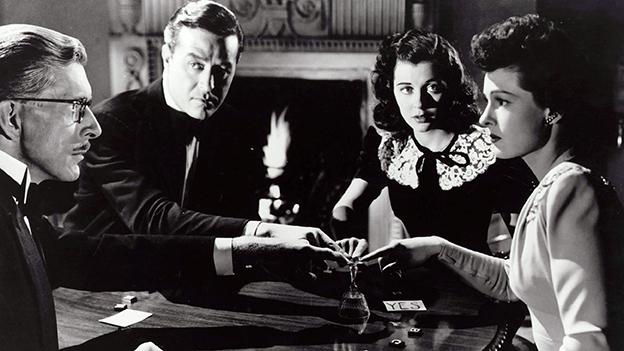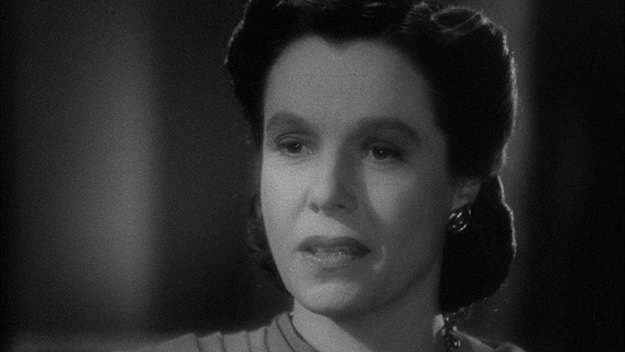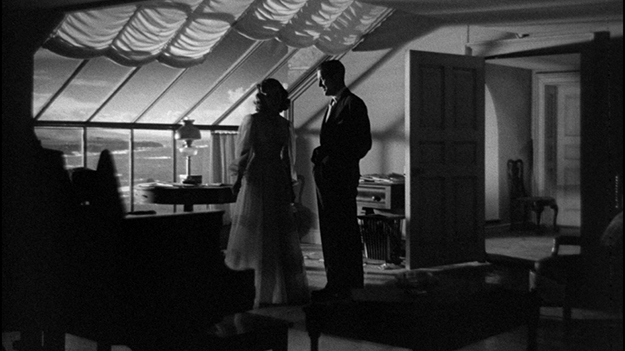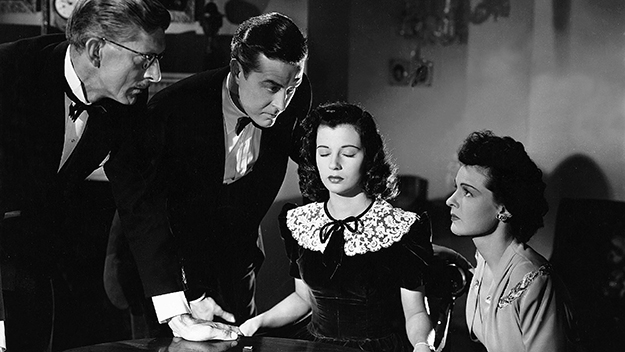Queer & Now & Then: 1944
In this biweekly column, Michael Koresky looks back through a century of cinema for traces of queerness, whether in plain sight or under the surface. Read the introductory essay.

Images from The Uninvited (Lewis Allen, 1944)
She appears from the dark or she comes in mist. She’s out of the past or here from lands unknown. She’s not of this earth anymore, yet she has a distinct effect on the material world. The attraction-repulsion she instills is born of sensuality as much as fear, and her threat almost always descends upon a living woman. Who is she, or who was she? These are the basic questions for a strange subgenre of horror movie that materialized in ’40s Hollywood.
The representation of women on screen was changing generally. Throughout the decade, for instance, the growth of the American film noir in conjunction with the country’s involvement in World War II and the concurrent proliferation of women entering the workforce saw the rise of the femme fatale—the villain whose strength was nevertheless also a symbol of empowerment, a crucial, if momentary, shifting of the gender power balance in moviemaking. In films like Double Indemnity, Detour, and Scarlet Street, Barbara Stanwyck, Ann Savage, and Joan Bennett are so fearsomely present that they’re undeniably their films’ centers of gravity. In many horror films of the era, however, something different yet equally complex was going on: women were attempting to control the narrative from another realm, demons or apparitions, decentered by virtue of their tenuous relation to space and time. And following the lead of Alfred Hitchcock’s hugely successful adaptation of Daphne du Maurier’s Rebecca, which kicked off the decade by winning the 1940 Best Picture Oscar, the ghostly or demonic forms these women took were somehow connected to a sexuality then deemed aberrant—the only way their possible queerness could be intimated was through a shroud of fog, depicted as a haunting.
The chic lesbianism that was so prevalent in early ’30s Hollywood—especially pronounced and unabashed in the decade’s pre-Code years—among such star personas as Marlene Dietrich, Greta Garbo, and Katharine Hepburn, seemed to have found its opposite reaction in the ’40s figure of the threatening woman, her strength connected somehow to transgression or perversity. In addition to the ghostly, unseen figure of Rebecca’s title character, and her unholy tethering to Judith Anderson’s obsessive Mrs. Danvers, one of cinema’s most famous, heavily coded lesbian figures, there’s Simone Simon’s shape-shifting Serbian exotic Irena in Cat People, who terrorizes and intimidates her husband’s lady pal in a locker room and who, in her inexplicable ghostly manifestation in The Curse of the Cat People, returns to ambiguously befriend a troubled little girl. In The Seventh Victim, a naïve young woman searches a sinister New York for her older sister, who has gone missing after falling under the spell of a group of Satanists, many of whom are women who seem to have a secret, sickly connection to each other; one of them, the butch Esther Redi—played by the unforgettable Mary Newton—tries to intimidate our heroine in the shower in a sequence that has been widely regarded as a precursor to Psycho, the silhouette of her pointy hat through the shower curtain looking like nothing so much as devil horns. Still another Val Lewton RKO production, I Walked with a Zombie, coasts on waves of ethereal female togetherness and spiritual possession. Yet it is Paramount’s Lewis Allen–directed haunted house movie The Uninvited that is perhaps the most startlingly overt example of the subgenre, its phantom lesbianism almost exhilarating in how it makes its subtext almost visible.

That the elegantly eerie The Uninvited, which had a large cult following for decades even before it was anointed as a classic by The Criterion Collection, has long been admired and discussed by many without clear acknowledgment of its central gay themes says a lot about the multiple levels on which American movies can function and the different covenants they create with viewers. The movie’s lesbian content can hardly be called undertone: so prevalent is it that queer theorist Patricia White’s excellent book on lesbian representation in classical Hollywood cinema is actually titled Uninvited in homage. Sure enough, White has been most eloquent on the subject, writing that in films such as these, “Lesbianism is the ghost in the machine, a sign of the body, desire, the other woman.” Allen’s film, based on a 1941 novel by Irish writer Dorothy Macardle, offers up its own Mrs. Danvers figure, the imposing Miss Holloway, who has secrets she’d prefer to carry to the grave. The Uninvited, like so many sexually cryptic films of the classical Hollywood era, is by turns transgressive and traditional, but as a ghost story it’s an especially perfect vessel for a queer love story: it’s all about the viewer’s perception.
Initially, The Uninvited seems as though it will be a quite conventional story about a haunted house exploration, following an urbane man and woman from London, played by Ray Milland and Ruth Hussey, who fall madly for and thus instantly buy a windswept, suspiciously cheap house perched on a cliff in southwestern England’s Cornwall peninsula. Yet even before they start hearing the disturbing sounds of weeping in the middle of the night, things feel a little off: our ostensible hero and heroine Rick and Pamela are not a married couple but a brother and sister. As the film continues, the choice to center the tale on inseparable, fully domesticated siblings may seem like a device to leave Rick open for a possible romance outside the household, but it’s more effectively destabilizing than that—it’s the first of multiple intimations of incestuous connections in a film that’s so much about the perverse, intergenerational, and constricting bonds of family.
Rick, a music writer looking for peace, quiet, and inspiration, hopes that he can get some melodies composed in that eerily calm room at the top of the landing. However, despite its amazing view of the sea’s crashing waves, we know something is off in this room, both because it’s so much colder than any other in the house and because the second a bouquet of flowers is set down in it, they wither and die as though hit by poisonous gas. Making things even more ominous is the alarmed response of the perturbed 20-year-old local Stella (Gail Russell), the granddaughter of the house’s owner, Commander Beech (Donald Crisp), upon their decision to buy the house: at first she tries to curb the sale by telling them it’s not on the market, and after they move in, she turns up on their front lawn, staring up at the house with longing and fear. Eventually she becomes a fixture in their lives, and Rick grows infatuated with the attractive yet disturbed young woman, though she deflects his advances, claiming to be too overtaken with memories of her traumatic past. Nevertheless, he’s inspired enough to write for her a serenade: “Stella by Starlight,” the Victor Young tune that would become a standard recorded by everyone from Charlie Parker to Ella Fitzgerald to Miles Davis. Here, the song contributes to the overall ethereal mood of the film, although it’s emanating from Stella’s deep, impenetrable well of sadness.

The dedicated song also seems to officially move the film away from the presumed—and extremely bland—protagonists Rick and Pamela, re-establishing Stella as the film’s true starlight. The haunting of Windward House turns out to be a kind of manifestation of Stella’s long-gestating grief. We deduce that the ghost who roams its halls and wails at night must be that of her mother, Mary Meredith, who died when Stella was an infant by falling—or was it jumping?—off the cliffs to the rocky shore below. At one point, Stella is compelled by some unseen force to nearly fling herself off the side of the cliff herself, leading one to fear the spirit might not be a benevolent mother figure after all. Upon further investigation, Rick and Pamela find out more about the past of the strange familial legacy they’ve unwittingly inherited, discovering that Stella’s artist father also had a Spanish mistress and muse, Carmel—whom, we discover, he painted in his studio at the top of the stairs. The scandalous story goes that the tempestuous Carmel, deranged with jealousy and anger, stole baby Stella from Mary before pushing the woman to her death, eventually dying herself, and leaving the girl to be raised by her grandfather.
The ghost’s appearance during a séance guided by an overturned wine glass further seems to confirm that the maternal spirit—whose arrival is commonly heralded by the scent of mimosa—is indeed attempting to protect Stella. But after the wine glass flies of its own volition into the crackling fireplace, Stella suddenly seems to have been possessed by a spirit and begins speaking in trancelike Spanish, her eyes closed. A silent, floating apparition materializes in the dark room, giving off a sense of danger rather than comfort. Terrified and terrorized, Stella seems in need of help, so Commander Beech whisks his granddaughter away from Windward, and calls in some assistance.
Enter Miss Holloway. Cut from the Mrs. Danvers cloth, Miss Holloway is embodied with sterility by the film’s coldest yet most charismatic performer, Cornelia Otis Skinner, who strikes a masculine, intimidating, no-nonsense pose in black suit and veiled hat as she appears at the foot of vulnerable Stella’s bed. Miss Holloway was Mary’s closest companion, and as we quickly come to ascertain, they were likely more than friends. Turning with intense reverence to the oversized oil painting of Stella’s mother hanging on the bedroom wall, she is quick to extol the long-dead woman’s virtues: “Mary was a goddess; her skin was radiant, and that bright, bright hair…” She nearly drifts into reverie: “The nights we sat by that fireplace, planning our whole lives. And it wasn’t flirtations and dresses we were talking about. We were no silly giggling girls. We intended to conquer life.” The owner of a mental health institution for troubled young women called—what else?—The Mary Meredith Retreat, Miss Holloway seems ominously delighted to have been granted access to Stella after all these years. “Years ago you should have let me have her,” she says to Beech, arch and upright but with a glint in her eye, her fingers like talons. At the end of the scene, in case the sinister, sexually tinged relationship between Miss Holloway and Mary Meredith was not clear enough, she turns to the portrait and says, “They shan’t ever find out, my darling, I promise you.”

The double meaning of that statement is the key to unlocking the mysterious forces that govern The Uninvited. As we’ll come to learn, Mary is not the warm maternal presence Stella thinks she is, and Carmel is not the villainous Other she has been painted to be. Mary and Miss Holloway’s shared “secret” is that Carmel is Stella’s real mother, who had given birth to her illicitly in Paris, and that the women had been knowingly passing Stella off as Mary’s child, while Miss Holloway continued to spread the lie that the “Spanish gypsy” was “evil.” Yet Miss Holloway’s declaration to her “darling” also signifies the need to continue hiding the facts about their relationship, their transgression but also their bond. The persistent power that Mary’s ghost has over the living therefore becomes inextricable from her cloaked sexuality. The film posits Mary’s queerness as connected to the fact that she never truly gave birth, putting her outside the bounds of “normal” feminine life, signifying a kind of rejection of heteronormative procreation. Mary and Miss Holloway are the unnaturals, and the truth must remain concealed, even after death.
Near the end of the film, Miss Holloway releases Stella from the institution and instructs her to go directly to Windward House, a knowingly dangerous directive since whenever she goes there, she’s either possessed or compelled to leap to her death. Does Miss Holloway want to ensure that the girl will meet her own violent end, just like her beloved Mary, in order to ensure that she never finds out the truth about her parentage? Or perhaps she hopes that Mary will fully possess the body of Stella, and then Miss Holloway can in turn possess Mary again. Though the latter is the more outlandish reading, this is the interpretation I prefer. Maybe it’s because, whatever the collateral damage these sexually aberrant women caused in their desire to keep secret their plans to “conquer life,” I want to believe that it was all worth it. And despite all the film’s desperate attempts to make Miss Holloway and Mary into a sinister duo, the flame that Miss Holloway still carries for Mary all these years later strikes me as nothing less than smolderingly romantic.
Michael Koresky is a writer, editor, and filmmaker in Brooklyn. He is cofounder and editor of the online film magazine Reverse Shot, a publication of Museum of the Moving Image; a regular contributor to the Criterion Collection and Film Comment, where he writes the biweekly column Queer and Now and Then; and the author of Terence Davies, published by University of Illinois Press, 2014.







